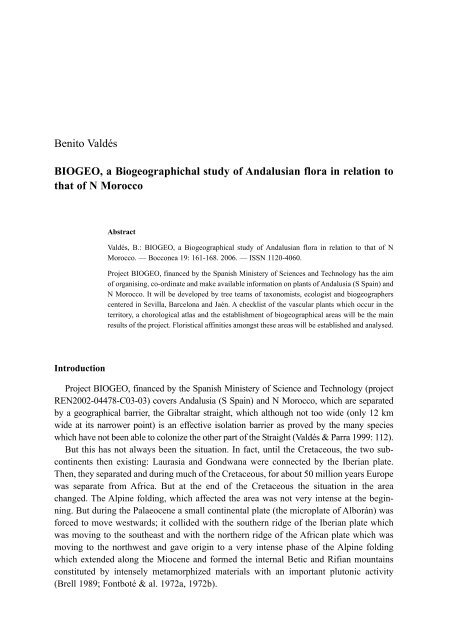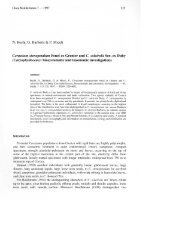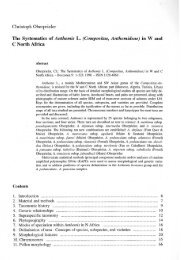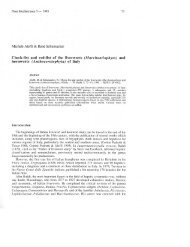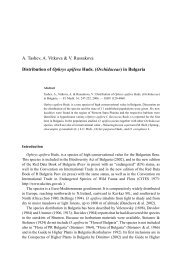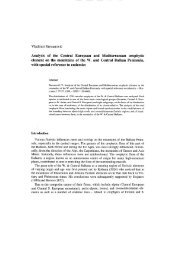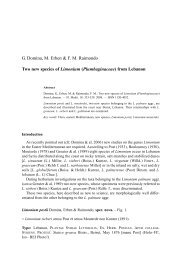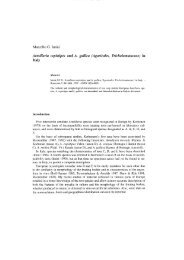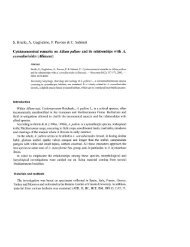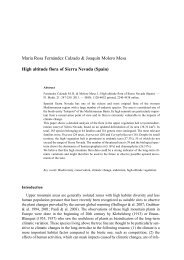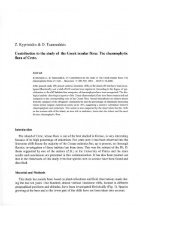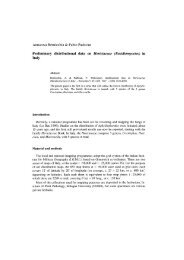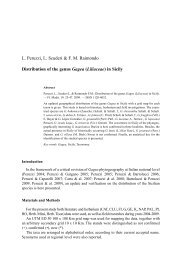Benito Valdés BIOGEO, a Biogeographichal study of ... - Herbmedit.org
Benito Valdés BIOGEO, a Biogeographichal study of ... - Herbmedit.org
Benito Valdés BIOGEO, a Biogeographichal study of ... - Herbmedit.org
Create successful ePaper yourself
Turn your PDF publications into a flip-book with our unique Google optimized e-Paper software.
<strong>Benito</strong> <strong>Valdés</strong><br />
<strong>BIOGEO</strong>, a <strong>Biogeographichal</strong> <strong>study</strong> <strong>of</strong> Andalusian flora in relation to<br />
that <strong>of</strong> N Morocco<br />
Introduction<br />
Abstract<br />
<strong>Valdés</strong>, B.: <strong>BIOGEO</strong>, a Biogeographical <strong>study</strong> <strong>of</strong> Andalusian flora in relation to that <strong>of</strong> N<br />
Morocco. — Bocconea 19: 161-168. 2006. — ISSN 1120-4060.<br />
Project <strong>BIOGEO</strong>, financed by the Spanish Ministery <strong>of</strong> Sciences and Technology has the aim<br />
<strong>of</strong> <strong>org</strong>anising, co-ordinate and make available information on plants <strong>of</strong> Andalusia (S Spain) and<br />
N Morocco. It will be developed by tree teams <strong>of</strong> taxonomists, ecologist and biogeographers<br />
centered in Sevilla, Barcelona and Jaén. A checklist <strong>of</strong> the vascular plants which occur in the<br />
territory, a chorological atlas and the establishment <strong>of</strong> biogeographical areas will be the main<br />
results <strong>of</strong> the project. Floristical affinities amongst these areas will be established and analysed.<br />
Project <strong>BIOGEO</strong>, financed by the Spanish Ministery <strong>of</strong> Science and Technology (project<br />
REN2002-04478-C03-03) covers Andalusia (S Spain) and N Morocco, which are separated<br />
by a geographical barrier, the Gibraltar straight, which although not too wide (only 12 km<br />
wide at its narrower point) is an effective isolation barrier as proved by the many species<br />
which have not been able to colonize the other part <strong>of</strong> the Straight (<strong>Valdés</strong> & Parra 1999: 112).<br />
But this has not always been the situation. In fact, until the Cretaceous, the two subcontinents<br />
then existing: Laurasia and Gondwana were connected by the Iberian plate.<br />
Then, they separated and during much <strong>of</strong> the Cretaceous, for about 50 million years Europe<br />
was separate from Africa. But at the end <strong>of</strong> the Cretaceous the situation in the area<br />
changed. The Alpine folding, which affected the area was not very intense at the beginning.<br />
But during the Palaeocene a small continental plate (the microplate <strong>of</strong> Alborán) was<br />
forced to move westwards; it collided with the southern ridge <strong>of</strong> the Iberian plate which<br />
was moving to the southeast and with the northern ridge <strong>of</strong> the African plate which was<br />
moving to the northwest and gave origin to a very intense phase <strong>of</strong> the Alpine folding<br />
which extended along the Miocene and formed the internal Betic and Rifian mountains<br />
constituted by intensely metamorphized materials with an important plutonic activity<br />
(Brell 1989; Fontboté & al. 1972a, 1972b).
162 <strong>Valdés</strong>: <strong>BIOGEO</strong>, a Biogeographical...<br />
As a consequence <strong>of</strong> the alpine folding which operated in this area, during the Miocene<br />
the Mediterranean resulted completely closed, and for a period <strong>of</strong> almost 20 million years<br />
the Iberian Peninsula and NW Africa remained connected. Then, at the end <strong>of</strong> the Tertiary,<br />
when most important climatic changes in W Mediterranean occurred, which produced the<br />
main syndromes which characterise the Mediterranean plants, this region formed a single<br />
geographycal unit. Plants could migrate Northwards or Southwards according to climatic<br />
changes and this unit shared a same flora.<br />
The situation changed in the Pliocene, about five million years ago, when Gibraltar<br />
Straight opened for a second time aproximately with the limits it has today. The floras <strong>of</strong><br />
S Spain and N Morocco evolved independently during the Pliocene and the Quaternary<br />
and a series <strong>of</strong> taxa which characterise both areas, including many vicariants, were formed.<br />
The Andalusian flora was better known that that <strong>of</strong> N Morocco, as there is a complete<br />
flora <strong>of</strong> W Andalusia (<strong>Valdés</strong> & al. 1987) and Flora Iberica (Castroviejo & al. 1987-2002),<br />
still in progress, constitute a detailled <strong>study</strong> <strong>of</strong> the variability <strong>of</strong> the Iberian Peninsula vascular<br />
plants. But a checklist <strong>of</strong> vascular plants <strong>of</strong> N Morocco has been recently published<br />
(<strong>Valdés</strong> & al. 2002). The conditions are consequently appropriate to project a <strong>study</strong> to compare<br />
both regions.<br />
Floristic richness<br />
The number <strong>of</strong> Vascular plants which occurs in Andalusia is estimated in about 4.000<br />
taxa, <strong>of</strong> which 463 are endemic (Hernández-Bermejo & Clemente 1994). The Vascular<br />
flora <strong>of</strong> N Morocco includes 3168 taxa (2.907 species, 231 subspecies, 21 varieties and 30<br />
hybrids; <strong>Valdés</strong> & al. 2006) <strong>of</strong> which 96 are endemic (<strong>Valdés</strong> & Montserrat 2003).<br />
Altogether floristic richness <strong>of</strong> Andalusia and N Morocco is estimated in c. 4700 taxa,<br />
<strong>of</strong> which over 15% are endemic.<br />
A rough comparison indicates that the flora <strong>of</strong> N Morocco shows a higher similarity<br />
with that <strong>of</strong> Andalusia than with the rest <strong>of</strong> Morocco, and that there are very similar floristic<br />
areas in both territories.<br />
A first very rough attempt to compare the flora <strong>of</strong> Andalusia and N Morocco (excluding<br />
the Forêt de la Mamora and the Beni-Snassen mountains) was proposed by <strong>Valdés</strong><br />
(1991) 15 years ago (Fig. 1). But to establish floristic links has to be done by a precise<br />
comparison at a species by species distribution base and by the <strong>study</strong> <strong>of</strong> the distribution <strong>of</strong><br />
the different biogeographical elements which occur in both areas.<br />
This is why project <strong>BIOGEO</strong> is being developed.<br />
The territory<br />
For this project, which structure and composition will be given bellow, Andalusia has<br />
been considered as the political region which includes the provinces <strong>of</strong> Jaén, Córdoba,<br />
Sevilla, Huelva, Cádiz, Málaga, Granada and Almería, and N Morocco as delimited by the<br />
Catalogue des Plantes Vasculaires du Nord du Maroc (<strong>Valdés</strong> & al. 2002), this is, including<br />
all Moroccan territories north <strong>of</strong> a line which extends from Sale-Rabat to Oujda and<br />
the Algerian frontier (Fig. 2).
Bocconea 19 — 2006 163<br />
Fig. 1. Floristic correspondence between areas <strong>of</strong> Andalusia and the Rif (Based on Sauvage & Vindt<br />
1952; Sauvage 1961; <strong>Valdés</strong> & al. 1987, Rivas Martínez 1987). 1. Atlantic littoral; 2. Guadalquivir,<br />
Loukkos and Sebou valleys; 3. Algeciras-Tanger; 4. Betic-Rifean mountains; 5. Guadix-Baza-Isoul;<br />
6. Cabo de Gata-Knor-Nador; 7. Sierra Morena; 8. Saka-Guercif (from <strong>Valdés</strong> 1991).<br />
For chorological purposes Andalusia has been divided into 26 units and Morocco in 20<br />
units (Fig. 2). These are provisional units based in biogeography, traditional uses, geology, etc.<br />
Project <strong>org</strong>anisation<br />
The <strong>org</strong>anisation <strong>of</strong> the project is shown in Fig. 3. There are three teams centered in<br />
Sevilla, Barcelona and Jaén. The team <strong>of</strong> Jaén will deal mainly with the biogeographical<br />
aspects <strong>of</strong> the project; the team <strong>of</strong> Barcelona covers computing and part <strong>of</strong> the taxonomical<br />
aspects, and the team <strong>of</strong> Sevilla part <strong>of</strong> the taxonomical and computing aspects and<br />
coordination. There are a total <strong>of</strong> 35 botanists directly involved in the project, as indicated<br />
in Fig. 4. But there are also several experts on particular groups which will collaborate at<br />
least with the preparation <strong>of</strong> one <strong>of</strong> the products <strong>of</strong> the project: a checklist <strong>of</strong> vascular<br />
plants <strong>of</strong> the area.<br />
The <strong>org</strong>anisation (Fig. 3) includes an executive group (B. <strong>Valdés</strong>, Sevilla; J. M.<br />
Montserrat, Barcelona and E. Cano, Jaén) and three working groups one on biogeography,<br />
one on computing and another on taxonomy.<br />
X. Font, as responsible for the computer working group has developed three computing programmes:<br />
one for data management (incorporation <strong>of</strong> herbarium and bibliographical data into<br />
the database: Programme Fagus), another for incorporation <strong>of</strong> data from phytosociological<br />
tables (Programme Quercus) and another for statistical data analysis (Programme Ginkgo).
164 <strong>Valdés</strong>: <strong>BIOGEO</strong>, a Biogeographical...<br />
Fig. 2. Geographical limits and natural areas. Andalusia: 1, Aracena Mountains; 2, Andévalo; 3,<br />
Sierra Morena; 4, Zújar; 5, Pedroches; 6, Campiña de Huelva and Condado-Aljarafe; 7, Guadalquivir<br />
plain; 8, W Littoral; 9, Guadalquivir Marshes; 10, Guadalquivir valley; 11, W Subbetic Mountains;<br />
12, Mágina; 13, E Subbetic Mountains: Cazorla, Segura, Las Villas; 14, Aljibe Mountains; 15,<br />
Serranía de Ronda; 16, Axarquía; 17, Antequera depression; 18, Granada depression; 19, Almijara-<br />
Trevenque; 20 Guadix-Baza and Guadiana Menor depression; 21, Lower Alpujarras, Contraviesa,<br />
Lújar and Gádor Mountains; 22, Sierra Nevada and Filabres Mountains; 23, Sierra de Baza; 24,<br />
María-Orce and Estancias Mountains; 25, The Altiplanos; 26, Almería. Morocco: 1, Tanger area; 2,<br />
W Rif; 3, Loukkos; 4, Gharb; 5, Atlantic Coast; 6, Forêt de la Mamora; 7, Zerhoun; 8, Central Pre-<br />
Rif; 9, High Ouerrha; 10, Ouezanne; 11, Central Rif; 12, Taguist area, 13, Imzorène; 14, Aknoul; 15,<br />
Tsoul; 16, Tazzeka; 17, Guercif area; 18, Kert Ganc; 19, Gareb area; 20, Beni-Snassen Mountains.<br />
Taxonomic activities are developed under five main programmes (see Fig. 3):<br />
1. Literature. A group is responsible for selecting bibiographical references which data<br />
have to be directly included into the database.<br />
2. T. Navarro (Málaga) coordinates the preparation <strong>of</strong> sample taxonomic revisions<br />
(Teucrium, Asphodelus, Euphorbia, Lithospermeae and Buxaceae).
Bocconea 19 — 2006 165<br />
Fig. 3. Project management and working groups.<br />
3. Herbaria management, including preparation and sending herbarium material to authors<br />
is the responsibility <strong>of</strong> a person in each <strong>of</strong> the four main herbaria to use for the project.<br />
4. Field expeditions to complete the floristical knowledge <strong>of</strong> those areas still poorly represented<br />
in the herbaria are co-ordinated by Z. Díaz Lifante.<br />
5. The preparation <strong>of</strong> a checklist <strong>of</strong> vascular plants which occur in the territory is co-ordinated<br />
by B. <strong>Valdés</strong> & J. M. Montserrat.<br />
Aims <strong>of</strong> the project<br />
The main aims <strong>of</strong> the project is to <strong>org</strong>anise, co-ordinate and make available information<br />
on the plants <strong>of</strong> Andalusia and N Morocco. This includes:<br />
1. To form an initial database <strong>of</strong> floristic, taxonomic and biogeographycal data based on<br />
available bibliographycal information. The starting point are: the Flora Vascular <strong>of</strong><br />
Andalucía Occidental (<strong>Valdés</strong> & al. 1987), the Catalogue des Plantes Vasculaires du<br />
Nord du Maroc (<strong>Valdés</strong> & al. 2002) and the published checklists <strong>of</strong> different E<br />
Andalusian areas. This initial database will be updated by the incorporation <strong>of</strong> new reliable<br />
literature.<br />
2. Critical identification <strong>of</strong> the bulk ammount <strong>of</strong> plant material still to be studied at<br />
Barcelona, Sevilla and other Andalusian herbaria.
166 <strong>Valdés</strong>: <strong>BIOGEO</strong>, a Biogeographical...<br />
Fig. 4. The teams.<br />
3. To incorporate to the herbaria BC, GDA, JAEN, MA and SEV the studied plant material.<br />
4. To collect and identify new herbarium material from poorly known areas.<br />
5. To incorporate to the database at a locality by locality bases the data resulting from the<br />
studied plant material.<br />
6. To establish a subdivision <strong>of</strong> the <strong>study</strong> area in working chorological units.<br />
7. To assign the recognised taxa to the working chorological units.<br />
8. To elaborate a checklist <strong>of</strong> vascular plants <strong>of</strong> Andalusia and N Morocco with identification<br />
keys.<br />
9. To elaborate a chorological atlas <strong>of</strong> vascular plants <strong>of</strong> Andalusia and N Morocco.<br />
10 . To propose a biogeographical sectorization <strong>of</strong> the <strong>study</strong> area.<br />
11. To establish the floristic affinities amongst the different biogeographical sectors <strong>of</strong><br />
Andalusia and N Morocco.<br />
12. To establish floristic affinities amongst the biogeographical sectors within Andalusia<br />
and within N Morocco.<br />
13. To <strong>study</strong> taxonomically several genera to check the fiability <strong>of</strong> the biogeographycal<br />
sectors and to establish a model <strong>of</strong> taxonomic traitment for a future preparation <strong>of</strong> a vascular<br />
flora <strong>of</strong> Andalusia and N Morocco.
Bocconea 19 — 2006 167<br />
Fig. 5. Project structure. Inputs and outputs.<br />
Project structure<br />
Information flow is summarised in fig. 5. Inputs include the data used to form the project<br />
database, which is basically a floristic core from which a series <strong>of</strong> products will be<br />
extracted.<br />
The floristic core includes:<br />
1. Accepted name, authority and place <strong>of</strong> publication for genera, species and subspecies.<br />
2. Selected synonyms with authority and place <strong>of</strong> publication.<br />
3. General distribution referred to worldwide distribution and within the <strong>study</strong> area indicated<br />
by the initial chorological sectors shown in Fig. 2.<br />
4. Assignation <strong>of</strong> taxa to floristic elements.<br />
5. Distribution <strong>of</strong> taxa at a locality by locality base, based mainly on herbarium material.<br />
6. Habitat, both the macrohabitat (general habitat) and microhabitat, substrate and altitude.<br />
7. Growth form.<br />
8. Phenology.<br />
The main products will be:<br />
1. A floristic checklist <strong>of</strong> vascular plants for the whole territory.<br />
2. A chorological atlas for species and subspecies <strong>of</strong> the area.
168 <strong>Valdés</strong>: <strong>BIOGEO</strong>, a Biogeographical...<br />
3. A biogeographical analysis which will result in the proposal <strong>of</strong> new chorological units<br />
for the territory based on biogeography.<br />
4. The establishment <strong>of</strong> floristic affinities amongst the different chorological units.<br />
Discussion<br />
This is a cooperative project which will be developed mainly by the components <strong>of</strong> the<br />
three teams involved in the project which have the responsibility to drown the project to a<br />
successful end. But a number <strong>of</strong> specialists from different institutions within and outside<br />
Spain will co-operate and will be responsible for the <strong>study</strong> <strong>of</strong> particular genera or groups<br />
<strong>of</strong> genera. According to the programme, the project will be completed by July-August<br />
2006.<br />
References<br />
Brell, J. M. 1989: Geología de España. – Pp. 254-279 in: Alvarado, R. (ed.), Historia Natural,<br />
Geología, 2ª ed. – Barcelona.<br />
Castroviejo, S. & al. (eds.) 1986-2001: Flora Iberica, 1-8, 14. – Madrid.<br />
Fontboté, J. M., Estévez, A., Navarro-Villa, F., Orozco, M. & Sanz, C. 1972a: Mapa geológico de<br />
España, 1:200.000 Cádiz.- Dept. Publ. Inst. Geol. Minero, Madrid.<br />
— , —, — , — & — 1972b: Mapa geológico de España, 1:200.000 Algeciras – Madrid.<br />
Hernández-Bermejo, J. E. & Clemente, M. 1994: Biodiversidad y Recursos Fitogenéticos en<br />
Andalucía. – Pp. 15-22 in Hernández-Bermejo, J. E. & Clemente, M. (eds.), Protección de la<br />
Flora en Andalucía. – Sevilla.<br />
<strong>Valdés</strong>, B. 1991: Andalucía and the Rif. Floristic links and a common Flora. – Bot. Chron. 10: 117-<br />
124.<br />
— & Montserrat, J. M. 2004: Botanical diversity and endemicity in N Morocco. – Phytol. Balc. 9<br />
(3): 479-485<br />
— & Parra, R. 1999: Difficulties in determining the distribution <strong>of</strong> species that occur in SW Europe.-<br />
Acta Bot. Fennica 16: 111-117.<br />
—, Montserrat, J. M. & Font, X. 2006: A Phytogeographycal analysis <strong>of</strong> the N Moroccan flora. –<br />
Willdenowia 36: 397-408.<br />
—, Rejdali, M., Achhal el Kadmiri, A., Jury, S. L. & Montserrat, J. M. 2002: Catalogue des Plantes<br />
Vasculaires du Nord du Maroc. – Madrid.<br />
—, Talavera, S. & Fernández-Galiano, E. 1987: Flora Vascular de Andalucía Occidental – Barcelona.<br />
Address <strong>of</strong> the author:<br />
<strong>Benito</strong> <strong>Valdés</strong>,<br />
Departamento de Biología Vegetal y Ecología, Facultad de Biología, Universidad de<br />
Sevilla, Avda. Reina Mercedes s/n, Sevilla, Spain.


